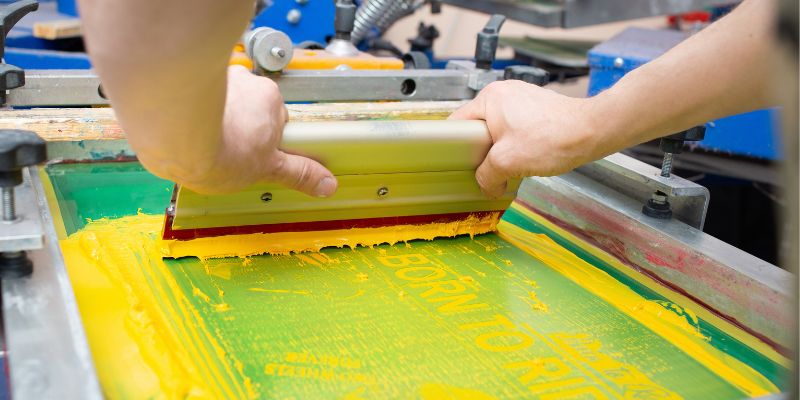Screen printing can create bright graphics on many surfaces, from cloth to posters. Popular for its adaptability, robustness, and capacity to create premium prints, this method has roots dating back centuries.
Screen printing keeps changing to benefit the fashion, marketing, and fine arts sectors. This article will discuss the definition, background, artwork, and professional screen printing technique to help explain why this technique is still preferred today.

Silk screen printing uses a mesh screen to spray ink onto a surface. By precisely blocking ink in designated regions, a stencil or pattern block leaves an impression of the picture on the substrate. This method is commonly used on fabrics, posters, signage, and even electronic circuit boards. One of the main advantages of screen printing, particularly on textiles like t-shirts or bags, is its capacity to create strong and brilliant prints.
The skilled screen printing process guarantees consistent outcomes, whether creating single or wholesale orders. This approach performs very nicely for bold, straightforward designs that call for solid color application. Every hue in the design calls for a different screen, laid over the cloth individually to create a vivid, multi-colored picture. Furthermore, other kinds of inks, including plastisol and water-based ones, are available depending on the intended result.
Main Advantages Of Screen Printing:
Screen printing has been around for more than a thousand years. It began in China during the Song Dynasty, where people screened silk cloth. The method eventually traveled to Japan and other areas of Asia, where it developed and grew more polished. Screen printing first found use as a commercial printing technique in the West in the early 20th century.
Artists like Andy Warhol popularized screen printing in the 1960s, introducing it into modern art. His legendary images of Marilyn Monroe and other well-known personalities represented the medium's capacity for combining commercial printing with art. From fashion to electronics, screen printing is still vital for commercial and artistic projects in many different sectors today.
Making artwork for screen printing calls for both particular techniques and careful thought. Developing a design fit for the technique comes first in the screen printing artwork process. That usually involves simplifying photos since printing can cause a loss of minute features. Usually, the pattern is layered, and each color denotes a different screen. It guarantees clear, clearly defined colors in the last print.
Screen printing extensively uses vector files since they enable scaling without losing quality. Creating these graphics is best done with programs like Adobe Illustrator or CorelDRAW. The next stage is screen preparation, whereby a photosensitive emulsion burns the design onto the mesh. Under light, this emulsion hardens and leaves just the pattern portions open to let ink pass through during printing.
Key Steps In Artwork Creation:
Screen preparation starts the step-by-step printing process. Once the design is complete, screens are made by laying a fine mesh material across a frame. After that, the mesh is covered with a light-sensitive emulsion and left to dry under darkness. Print the design onto transparent paper and then cover the screen. The emulsion hardens in response to light, leaving just the design portions unaltered. These washed-out patches produce a stencil on the screen.
The ink is sprayed on the screen and run across the mesh using a squeegee. The design is transferred when the ink runs across the stencil onto the material. Every hue in the design is followed through the procedure. Once the print is finished, the material dries; in the case of fabrics, the ink may be cured under heat to guarantee permanence.
Steps In The Screen Printing Process:

Screen printing is used in many different fields, from fashion to marketing to electronics. The fashion industry most often uses this approach to create custom t-shirts, hoodies, and other clothing. The electronics sector prints circuit boards, and marketing campaigns sometimes depend on screen printing to create promotional items, including posters and signs.
As technology developed, screen printing grew greener and more effective. For instance, water-based inks have less environmental effects than conventional plastisol inks. Furthermore, the speedier and more consistent development of automatic screen printing machines has allowed companies to satisfy greater demand without compromising quality.
Common Screen Printing Applications:
For those who give durability, vivid colors, and cost-effectiveness for bigger runs top priority, screen printing is still the best option for which approach to employ. Over the years, the professional screen printing method has been refined to guarantee that prints remain brilliant and last longer, particularly on fabrics.
Screen printing is famous for handling big volumes while preserving great quality, whether you are creating personalized clothing, signage, or big promotional items. Digital or heat transfer printing may be more suited for short runs or highly detailed designs, but screen printing excels when long-lasting results are crucial.
Rich in history, screen printing is a great way to produce excellent prints. From durability to the capacity to manage intricate designs, this flexible approach has several advantages, whether for artistic expression or business purposes. Screen printing changes with technology; new machinery and environmentally friendly inks also make it more efficient. This approach is still a mainstay in both sectors and the arts, whether you are interested in learning about the screen printing process explained or exploring how the professional screen printing technique operates.

By Triston Martin/Oct 29, 2024

By Eleanor/Mar 13, 2024

By Eleanor/Apr 13, 2024

By Eleanor/May 13, 2024

By Frederica/Mar 12, 2024

By Kristina Cappetta/May 28, 2025

By Peter Evans/Mar 04, 2024

By Eleanor/Oct 29, 2024

By Darnell Malan/Oct 13, 2024

By Alice Ellis/Apr 23, 2024

By Frederica/Dec 02, 2024

By Eleanor/Apr 19, 2024